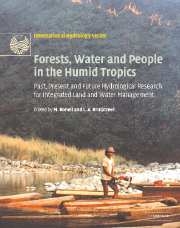 Forests, Water and People in the Humid Tropics
Forests, Water and People in the Humid Tropics from Part IV - New methods for evaluating effects of land-use change
Published online by Cambridge University Press: 12 January 2010
INTRODUCTION
Accelerated soil and nutrient losses and their off-site impacts are of great concern for sustainable agriculture and, more generally, for sustainable land management. Prediction of the rate of soil erosion over a range of temporal and spatial scales is important for land use planning, erosion risk assessment, and for evaluating the effects of land use change (Penning de Vries et al., 1998). With urbanisation and population growth in traditionally rural areas, farming on steeplands has continued to increase in recent years, especially in the developing regions of the world (Oldeman et al., 1991; Fisher and Heilig, 1997). In plantation forestry, logging and site preparation activities on steep slopes also expose forested areas temporarily to high risk of soil erosion and nutrient losses (cf. the chapter by Grip et al., this volume).
The most widely used soil erosion prediction technology is the Universal Soil Loss Equation (USLE) (Wischmeier and Smith, 1978) and its successor the Revised USLE (Renard et al., 1997). In recent years, however, a new generation of physically based models such as WEPP (Nearing et al., 1989; Flanagan and Nearing, 1995; Laflen et al., 1997), LISEM (De Roo et al., 1996a), EUROSEM (Morgan et al., 1998) and GUEST (Misra and Rose, 1996; Rose et al., 1997) has been developed to describe and quantify soil erosion processes. These models are particularly suitable for adaptation across a range of scales in the landscape because physical principles and physically meaningful parameters are involved.
To save this book to your Kindle, first ensure [email protected] is added to your Approved Personal Document E-mail List under your Personal Document Settings on the Manage Your Content and Devices page of your Amazon account. Then enter the ‘name’ part of your Kindle email address below. Find out more about saving to your Kindle.
Note you can select to save to either the @free.kindle.com or @kindle.com variations. ‘@free.kindle.com’ emails are free but can only be saved to your device when it is connected to wi-fi. ‘@kindle.com’ emails can be delivered even when you are not connected to wi-fi, but note that service fees apply.
Find out more about the Kindle Personal Document Service.
To save content items to your account, please confirm that you agree to abide by our usage policies. If this is the first time you use this feature, you will be asked to authorise Cambridge Core to connect with your account. Find out more about saving content to Dropbox.
To save content items to your account, please confirm that you agree to abide by our usage policies. If this is the first time you use this feature, you will be asked to authorise Cambridge Core to connect with your account. Find out more about saving content to Google Drive.